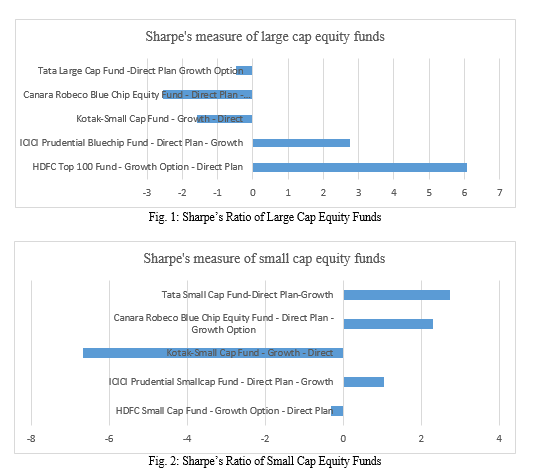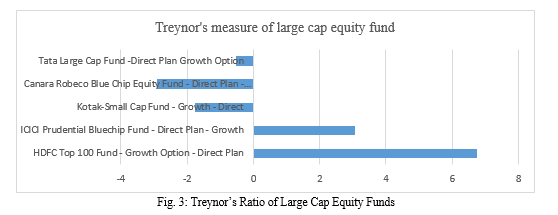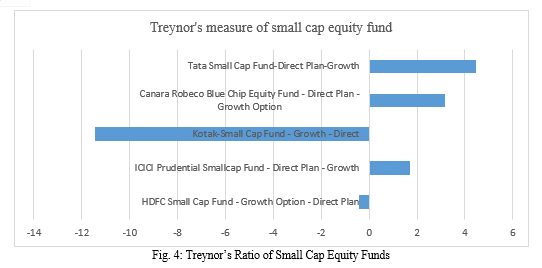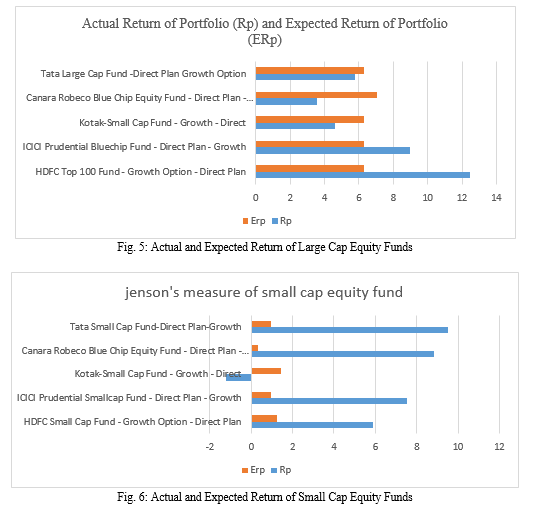Ijraset Journal For Research in Applied Science and Engineering Technology
- Home / Ijraset
- On This Page
- Abstract
- Introduction
- Conclusion
- References
- Copyright
Performance Evaluation of Selected Open-Ended Mutual Fund Schemes in India
Authors: Dr. Ishwar Sharma, Bharti , Bhawana Verma, Chanchal Saini
DOI Link: https://doi.org/10.22214/ijraset.2023.48519
Certificate: View Certificate
Abstract
Mutual funds are considered as the best investment option because they offer a higher return with little risk. The study’s main aim is to evaluate the performance of selected large and small cap equity mutual fund schemes. The performance has been analysed in terms of return and risk using risk-adjusted performance measures. The present study is descriptive and secondary data has been collected from the website of BSE, NSE and Mutual funds. The analysis shows that “HDFC Top 100 Fund - Growth Option - Direct Plan” is top large cap mutual funds scheme and “Tata Small Cap Fund-Direct Plan-Growth” is top small cap mutual funds scheme among the selected funds as per Sharpe, Treynor and Jenson ratio.
Introduction
I. INTRODUCTION
There are many financial instruments accessible in India, but one of the most attractive financial investment vehicles that are essential to a nation's economy is the mutual fund. In our nation, there are a wide variety of investment opportunities. As a result, the investor is unaware of the best types of investment options for him. To get maximum return with minimum risk, they should diversify their portfolio and portfolio diversification is based on the principle of “Do not put all the eggs in one basket”. Mutual Fund provides diversification benefit to investors. Mutual fund schemes are the best investment choice (Murthy et al., 2022). Mutual funds offer greater return with less risk (Duggimpudi et al.,2010). The establishment of Unit Trust of India in 1963 marked the beginning of the mutual fund industry in India. A mutual fund is a company that collects small sums of money from the general public with the intention of investing it in securities. Mutual funds are financial institutions that pool money from individual investors and invest it in a variety of securities and other assets. The foundation of mutual funds is the concept of "Trusteeship," which refers to acting on behalf of another party in the interest of another party and providing that party with protection. In order to determine whether mutual fund schemes in India are outperforming or underperforming the benchmark, it is necessary to evaluate their performance. The performance of a portfolio is evaluated by compare it to the market index. If a mutual funds scheme provides more return than its benchmark index then it is outperformed mutual funds scheme but if it provides less return than its benchmark index then then it is outperformed mutual funds scheme. Sharpe, Treynor and Jenson ratio are the statistical techniques to evaluate the performance of portfolio (Kaur & Chaudhary, 2021; Shreekant et al., 2021; Vasani, 2020).
II. LITERATURE REVIEW
Chaudhari (2020) examined the hybrid mutual fund scheme's performance in India. The findings of the study shows that Market sentiments were found to have a greater impact on aggressive hybrid mutual funds than on conservative ones. Kalebar & Shah (2019) assessed balanced mutual funds' performance in India. The majority of funds have produced superior returns and have done well in the market. Kaur & Chaudhary (2021) examined the ethical mutual fund scheme's performance. Data of schemes has been collected from 2014 to 2020. Measures such as Jensen's alpha, Treynor's ratio, and Sharpe's ratio have been used. Their findings showed that during the study period, nine out of ten moral schemes outperformed the benchmark index. This suggests that ethical investment strategies produced profitable returns with minimal risk. Kumar (2019) examined the Indian equities mutual fund market performance. The results demonstrate that over the long term, mutual fund schemes produce above-average returns. Maheswari (2020) examined how well the various Axis Mutual Funds programmes performed. According to the data, the majority of the funds chosen for the study outperformed. Singh (2019) examined the performance of Indian mutual funds with a diverse equities portfolio. The data shows that the majority of the studied funds have outperformed. Tripathi & Japee (2020) assessed the effectiveness of quality mutual fund systems. The study came to the conclusion that 10 out of 15 funds did well in a very unpredictable market. Vasani (2020) examined the Midcap Equity Mutual Funds scheme's performance.
Based on Sharpe, Treynor, and Jensen's performance measure, it was discovered that Axis Blue Chip Midcap, Invesco India Midcap, and Kotak Emerging Equity Fund outperformed. Virparia (2022) examined the mutual fund performance of large cap, mid size, and small cap funds. It was discovered that investments in large and small cap funds are more profitable in the short term, but mid cap investments are more profitable in the long run. Shreekant et al. (2021) investigated the performance of both active and passive mutual funds in India. They discovered that actively managed portfolios outperformed in comparison to passive portfolios. Choksi & Bhatt (2020) analysed the scheme for large cap mutual funds. The research shows that “ICICI Prudential Bluechip Equity Fund”, “LIC MF Large Cap Fund”, and “DSP Top 100 Equity Fund” had the highest returns among the selected funds. Wachasunder (2017) studied the large cap equity funds plan. According to the study, among the chosen funds, Edelweiss Exchange Traded Scheme - Regular Plan is seen as a fund with moderate risk and moderate returns, while Birla Sun Life Top 100 Fund - Direct Plan is regarded as a fund with high risk and high returns. Somaiya (2022) investigated how the coronavirus crisis affected ELSS mutual fund performance. Throughout 2018–19 and 2019–20, each fund produced a very meagre return or perhaps a loss. But after the corona pandemic recovery in 2020–21, every fund started to provide incredible results. Roy & Ghosh (2012) evaluated the efficiency of private and public mutual fund schemes during the recession. They discovered that Birla Sun Life, an Indian private sector MF company, performs better than the public sector (UTI). Duggimpudi et al. (2010) examined diversified equity mutual funds in India. They discovered that mutual funds offer greater return with less risk. Vasantha et al. (2013) examined the performance of a few selected open ended equities diversified mutual funds. They discovered that the majority of the funds had negative returns, and no fund had particularly impressive performance. Panigrahi et al. (2020) examined Mutual funds' Equity Linked Savings Scheme performance and it was discovered that most funds had outperformed. Murthy et al. (2022) assessed the effectiveness of equity mutual funds. The majority of mutual funds gave good returns during the research period, they discovered. In the capital market, mutual funds are the best investment option.
III. RESEARCH METHODOLOGY
A. Data
Secondary data has been used to evaluate the performance of mutual fund schemes. The historical daily NAV data of different Mutual Fund Schemes has been collected from the website of Mutual Funds i.e. www.amfiindia.com and the data of benchmark indices of selected mutual funds scheme has been collected from the website of BSE and NSE i.e. www.bseindia.com, and www.nseindia.com, over the period of one year from December 29, 2021 to December 29, 2022. The yield on central government dated securities is obtained from the RBI website and is 6.28, which is considered as the risk-free rate.
B. Statistical Technique
Sharpe, Treynor and Jenson ratios are the statistical techniques which has been applied to evaluate the performance of different mutual funds schemes.
C. Sample
Five open ended large cap mutual funds schemes and five open ended small cap mutual funds schemes has been selected for study purpose.
Table I: Selected open ended large and small cap mutual funds schemes
|
Open ended Large Cap equity Funds |
||
|
Mutual Fund |
Mutual Fund Schemes |
Benchmark Index |
|
HDFC Mutual Fund |
HDFC Top 100 Fund - Growth Option - Direct Plan |
NIFTY 100 |
|
ICICI Prudential Mutual Fund |
ICICI Prudential Bluechip Fund - Direct Plan - Growth |
NIFTY 100 |
|
Kotak Mahindra Mutual Fund |
Kotak Bluechip Fund - Growth - Direct |
NIFTY 100 |
|
Canara Robeco Mutual Fund
|
Canara Robeco Blue Chip Equity Fund - Direct Plan - Growth Option |
S&P BSE 100 |
|
Tata Mutual Fund |
Tata Large Cap Fund -Direct Plan Growth Option |
NIFTY 100 |
|
Open ended Small Cap equity Funds |
||
|
HDFC Mutual Fund |
HDFC Small Cap Fund - Growth Option - Direct Plan |
S&P BSE 250 SmallCap Total Return Index |
|
ICICI Prudential Mutual Fund |
ICICI Prudential Smallcap Fund - Direct Plan - Growth |
NIFTY Smallcap 250 |
|
Kotak Mahindra Mutual Fund |
Kotak-Small Cap Fund - Growth - Direct |
NIFTY Smallcap 250 |
|
Canara Robeco Mutual Fund |
Canara Robeco Small Cap Fund - Direct Plan - Growth Option |
NIFTY Smallcap 250 |
|
Tata Mutual Fund |
Tata Small Cap Fund-Direct Plan-Growth |
NIFTY Smallcap 250 |
Source: website of Mutual Funds (www.amfiindia.com)
IV. DATA ANALYSIS AND INTERPRETATION
By using performance measurement ratios, which are employed in portfolio analysis, mutual fund performance can be examined. Sharpe, Treynor and Jenson’s ratios has been used to evaluate the performance of selected mutual fund schemes.
A. Sharpe’s Index
Sharpe's index is founded on the fundamental idea that a mutual fund's performance can be expressed in terms of excess return. The Sharpe Ratio assesses the excess return in relation to risk of the fund (i.e. total risk). This ratio illustrates the relationship between the total portfolio risk, expressed as the standard deviation of the returns, and the excess return over the risk-free return. A Mutual Fund that has a high Sharpe Ratio and a positive value has great risk-adjusted performance, while one that has a low Sharpe Ratio and a negative value has poor performance.
Sp = Rp – Rf/ S.D
Where, Sp = Sharpe`s Index, Rp = Returns of mutual fund schemes
Rf = Risk free rate of Return, S.D = Standard Deviation of mutual fund schemes
Table II: Performance evaluation by using Sharpe’s measure
|
Open ended Large Cap equity Funds |
|||||
|
Mutual Fund Scheme |
Rp (%) |
Rf (%) |
S.D. |
Sharpe’s Ratio (Rp – Rf/ S.D) |
Rank |
|
HDFC Top 100 Fund - Growth Option - Direct Plan |
12.44
|
6.28 |
1.02
|
6.07
|
1 |
|
ICICI Prudential Bluechip Fund - Direct Plan - Growth |
8.97
|
6.28 |
0.98
|
2.76
|
2 |
|
Kotak-Small Cap Fund - Growth - Direct |
4.59
|
6.28 |
1.06
|
-1.59
|
4 |
|
Canara Robeco Blue Chip Equity Fund - Direct Plan - Growth Option |
3.58
|
6.28 |
1.06
|
-2.54
|
5 |
|
Tata Large Cap Fund -Direct Plan Growth Option |
5.8
|
6.28 |
1.02
|
-0.47
|
3 |
|
Open ended Small Cap equity Funds |
|
||||
|
HDFC Small Cap Fund - Growth Option - Direct Plan |
5.90
|
6.28 |
1.23
|
-0.31
|
4 |
|
ICICI Prudential Smallcap Fund - Direct Plan - Growth |
7.51
|
6.28 |
1.17
|
1.05
|
3 |
|
Kotak-Small Cap Fund - Growth - Direct |
-1.24
|
6.28 |
1.13
|
-6.66
|
5 |
|
Canara Robeco Small Cap Fund - Direct Plan - Growth Option |
8.83
|
6.28 |
1.10
|
2.31
|
2 |
|
Tata Small Cap Fund-Direct Plan-Growth |
9.50
|
6.28 |
1.17
|
2.74
|
1 |
Source: author’s own calculation

The sharpe ratio of the open-ended large and small-cap mutual funds is displayed in the Table II. In case of large cap equity funds, “HDFC Top 100 Fund - Growth Option - Direct Plan” is providing higher return i.e. 12.44% and “ICICI Prudential Bluechip Fund - Direct Plan – Growth” plan is having lower risk because it is having low standard deviation i.e. 0.98. “HDFC Top 100 Fund - Growth Option - Direct Plan” of HDFC mutual funds got rank first as it is having higher sharpe ratio and “Canara Robeco Blue Chip Equity Fund - Direct Plan - Growth Option” got Fifth rank as it is having lower sharpe ratio among studied mutual fund schemes. Figure 1 shows the graphical representation of sharpe’s measure of large cap equity funds which is showing that out of five mutual fund schemes, two schemes are having positive sharpe ratio and three schemes are having negative sharpe ratio.
In case of small cap equity funds, “Tata Small Cap Fund-Direct Plan-Growth” is providing higher return i.e. 9.50 and “Canara Robeco Small Cap Fund - Direct Plan - Growth Option” is having lower risk because it is having low standard deviation i.e. 1.10. “Tata Small Cap Fund-Direct Plan-Growth” of Tata mutual funds got rank first as it is having higher sharpe ratio and “Kotak-Small Cap Fund - Growth – Direct” got Fifth rank as it is having lower sharpe ratio among studied mutual fund schemes. Figure 2 shows the graphical representation of sharpe’s measure of small cap equity funds which is showing that out of five mutual fund schemes, three schemes are having positive sharpe ratio and two schemes are having negative sharpe ratio.
B. Treynor’s Index: (Reward to Variability)
According to this approach, a managed portfolio needs to earn more than risk-free returns. The risk in mutual funds can be measured in terms of "Beta," which indicates systematic risk. This method makes the assumption that a managed portfolio doesn't have non-systematic risk. Treynor ratio examines the relationship between a fund's excess return over risk-free return and market risk, which is determined by beta. The performance of a portfolio improves with increasing Treynor ratio values.
Treynor Ratio = Rp – Rf/βp, Rp = Return of mutual funds scheme, Rf = Risk free rate of Return, βp = Beta of the mutual funds scheme
Table III: Performance evaluation by using Treynor’s measure
|
Open ended Large Cap equity Funds |
|||||
|
Mutual Fund Scheme |
Rp (%) |
Rf (%) |
βp |
Treynor’s Ratio (Rp – Rf/βp) |
Rank |
|
HDFC Top 100 Fund - Growth Option - Direct Plan |
12.44
|
6.28 |
0.91
|
6.76
|
1 |
|
ICICI Prudential Bluechip Fund - Direct Plan - Growth |
8.97
|
6.28 |
0.88
|
3.06
|
2 |
|
Kotak-Small Cap Fund - Growth - Direct |
4.59
|
6.28 |
0.96
|
-1.78
|
4 |
|
Canara Robeco Blue Chip Equity Fund - Direct Plan - Growth Option |
3.58
|
6.28 |
0.93
|
-2.90
|
5 |
|
Tata Large Cap Fund -Direct Plan Growth Option |
5.8
|
6.28 |
0.92
|
-0.52
|
3 |
|
Open ended Small Cap equity Funds |
|
||||
|
HDFC Small Cap Fund - Growth Option - Direct Plan |
5.90
|
6.28 |
0.88
|
-0.43
|
4 |
|
ICICI Prudential Smallcap Fund - Direct Plan - Growth |
7.51
|
6.28 |
0.73
|
1.69
|
3 |
|
Kotak-Small Cap Fund - Growth - Direct |
-1.24
|
6.28 |
0.66
|
-11.44
|
5 |
|
Canara Robeco Small Cap Fund - Direct Plan - Growth Option |
8.83
|
6.28 |
0.81
|
3.16
|
2 |
|
Tata Large Cap Fund -Direct Plan Growth Option |
9.50
|
6.28 |
0.72
|
4.45
|
1 |
Source: author’s own calculation


Table III demonstrate the Treynor ratio of large and small cap equity funds. In case of large cap equity funds, “HDFC Top 100 Fund - Growth Option - Direct Plan” is providing higher return i.e. 12.44% and “ICICI Prudential Bluechip Fund - Direct Plan – Growth plan” is having lower risk because it is having lesser beta value i.e. 0.88. “HDFC Top 100 Fund - Growth Option - Direct Plan” of HDFC mutual funds got rank first as it is having higher sharpe ratio and “Canara Robeco Blue Chip Equity Fund - Direct Plan - Growth Option” got Fifth rank as it is having lower sharpe ratio among studied mutual fund schemes. Figure 3 shows the graphical representation of Treynor’s measure of large cap equity funds which is showing that out of five mutual fund schemes, two schemes are having positive Treynor ratio and three schemes are having negative Treynor ratio.
In case of small cap equity funds, “Tata Small Cap Fund-Direct Plan-Growth” is providing higher return i.e. 9.50 and “Kotak-Small Cap Fund - Growth – Direct” is having lower risk because it is having lesser beta value i.e. 0.88. “Tata Small Cap Fund-Direct Plan-Growth” of Tata mutual funds got rank first as it is having higher Treynor ratio and “Kotak-Small Cap Fund - Growth – Direct” got Fifth rank as it is having lower Treynor ratio among studied mutual fund schemes. Figure 4 shows the graphical representation of Treynor’s measure of small cap equity funds which is showing that out of five mutual fund schemes, three schemes are having positive Treynor ratio and two schemes are having negative Treynor ratio.
C. Jenson’s Index: (Reward to Risk Ratio)
It is based on the fundamental of CAPM. Jenson’s index is calculated by using this formula: Erp = Rf + βp (Erm – Rf)
Where, Erp = Expected Returns from mutual funds, Rf = Risk Free Rate of Return
Βp = Beta of mutual fund schemes under evaluation, Erm= Return on Market Portfolio (benchmark index of selected mutual fund schemes)
Decision Making:
If the actual returns of portfolio (Rp) is more than the expected returns (Erp) are considered to be the better performance.
If the actual returns of portfolio (Rp) is equal than the expected returns (Erp) are considered to be the performing as expected.
If the actual return of portfolio (Rp) is less than the expected returns (Erp) are considered to be the poor performance.
Table IV: Performance evaluation by using Jenson’s measure
|
SCHEME NAME |
Rf (%) |
βp |
Erm (%) |
Rp (%) |
Erp (%) |
Performance |
|
Open ended large Cap equity Funds |
||||||
|
HDFC Top 100 Fund - Growth Option - Direct Plan |
6.28
|
0.91
|
6.31
|
12.44
|
6.307
|
Outperformed (Rp>ERp) |
|
ICICI Prudential Bluechip Fund - Direct Plan - Growth |
6.28 |
0.88
|
6.31
|
8.97
|
6.306
|
Outperformed (Rp>ERp) |
|
Kotak-Small Cap Fund - Growth - Direct |
6.28 |
0.96
|
6.31
|
4.59
|
6.308
|
underperformed (Rp<ERp) |
|
Canara Robeco Blue Chip Equity Fund - Direct Plan - Growth Option |
6.28 |
0.93
|
7.11
|
3.58
|
7.05
|
underperformed (Rp<ERp) |
|
Tata Large Cap Fund -Direct Plan Growth Option |
6.28 |
0.92
|
6.31
|
5.8
|
6.31
|
underperformed (Rp<ERp) |
|
Open ended Small Cap equity Funds |
||||||
|
HDFC Small Cap Fund - Growth Option - Direct Plan |
6.28 |
0.88
|
0.59
|
5.90
|
1.25
|
Outperformed (Rp>ERp) |
|
ICICI Prudential Smallcap Fund - Direct Plan - Growth |
6.28 |
0.73
|
-1.08
|
7.51
|
0.94
|
Outperformed (Rp>ERp) |
|
Kotak-Small Cap Fund - Growth - Direct |
6.28 |
0.66
|
-1.08
|
-1.24
|
1.44
|
underperformed (Rp<ERp) |
|
Canara Robeco Small Cap Fund - Direct Plan - Growth Option |
6.28 |
0.81
|
-1.08
|
8.83
|
0.34
|
Outperformed (Rp>ERp) |
|
Tata Small Cap Fund-Direct Plan-Growth |
6.28 |
0.72
|
-1.08
|
9.50
|
0.96
|
Outperformed (Rp>ERp) |

The results of the large cap and small cap mutual fund schemes are shown in Table IV using Jenson's methodology. Actual and expected return of large cap equity funds is graphically depicted in Fig. 5, and actual and expected return of large cap equity funds is graphically depicted in Fig. 6. Out of five large equity cap mutual fund schemes, two mutual funds scheme i.e. “HDFC Top 100 Fund - Growth Option - Direct Plan” and “ICICI Prudential Bluechip Fund - Direct Plan – Growth” are outperforming and three mutual fund schemes i.e. “Kotak-Small Cap Fund - Growth – Direct”, “Canara Robeco Blue Chip Equity Fund - Direct Plan - Growth Option” and “Tata Large Cap Fund -Direct Plan Growth Option” are underperforming. Out of five small equity cap mutual fund schemes, four mutual fund schemes are outperforming and these are “HDFC Small Cap Fund - Growth Option - Direct Plan”, “ICICI Prudential Smallcap Fund - Direct Plan – Growth”, “Canara Robeco Small Cap Fund - Direct Plan - Growth Option” and “Tata Small Cap Fund-Direct Plan-Growth”. “Kotak-Small Cap Fund - Growth – Direct” is not performing well.
Conclusion
Generally, mutual funds are considered good investment avenue as it provides higher return with minimum risk. The current study, however, discovers that not all the mutual funds performed well after using statistical tools. All of the chosen mutual fund schemes are producing positive returns, with the exception of “Kotak-Small Cap Fund - Growth – Direct”. As a result of having beta values below one, all of the selected mutual fund schemes are less risky. According to Jenson\'s meausre, two large cap equities fund schemes—\"HDFC Top 100 Fund - Growth Option - Direct Plan\" and \"ICICI Prudential Bluechip Fund - Direct Plan - Growth\"—are outperforming mutual fund schemes. These two schemes also have positive Sharpe and Treynor ratios. In addition, the \"Kotak-Small Cap Fund - Growth - Direct,\" \"Canara Robeco Blue Chip Equity Fund - Direct Plan - Growth Option,\" and \"Tata Large Cap Fund -Direct Plan Growth Option\" are underperforming with negative Treynor and Sharpe ratios.
References
[1] Chaudhari, N. (2020). Performance Evaluation of Selected Hybrid Mutual Funds In India. A Global Journal of Interdisciplinary Studies, 3(3), 52–56. [2] Choksi, M., & Bhatt, P. (2020). Performance Analysis of Mutual Funds: A Study on Selected Large Cap Mutual Funds In India. Sambodhi. [3] Duggimpudi, R. R., Abdou, H., & Zaki, M. (2010). An evaluation of equity diversified mutual funds: The case of the Indian market. Investment Management and Financial Innovations, 7(4), 66–73. [4] Kalebar, R. U., & Shah, M. K. (2019). Performance Evaluation of Selected Balanced Mutual Funds in India. International Journal of Research in Humanities, Arts and Literature. [5] Kaur, J., & Chaudhary, R. (2021). A Performance Evaluation of Ethical Mutual Funds: Evidence from India. Colombo Business Journal, 12(2). [6] Kumar, V. (2019). Performance Analysis of Select Equity Mutual Funds in India. Research Review International Journal of Multidisciplinary, 4(05), 1476–1479. [7] Maheswari, Y. (2020). A Comparative Study on Performance of Selected Mutual Funds in India. Available at SSRN 3615774. [8] Murthy, J., Anjaneyulu, M. S. R., Bhatt, M. H., & Kumar, M. D. S. (2022). Performance Evaluation Of Mutual Funds: A Study On Selected Equity Mutual Funds In India. Journal of Positive School Psychology, 6(9), 1124–1132. [9] Panigrahi, C. M. A., Mistry, M., Shukla, R., & Gupta, A. (2020). A study on performance evaluation of equity linked saving schemes (ELSS) of Mutual funds. NMIMS Journal of Economics and Public Policy, 5(1). [10] Roy, S., & Ghosh, S. K. (2012). A Comparative Study of Mutual Fund Performance during Recession in India. International Journal of Financial Management, 2(2). [11] Shreekant, G., Rai, R. S., Raman, T. V., & Bhardwaj, G. N. (2021). Performance Evaluation of Actively Managed and Passive (Index) Mutual Funds in India. International Journal of Management, 11(12), 1138–1147. [12] Singh, A. (2019). A Study on Selected Equity Diversified Mutual Funds in India. International Journal for Research in Applied Science and Engineering Technology, 7(9), 249–254. https://doi.org/10.22214/ijraset.2019.9036 [13] Somaiya, J. (2022). Effect of Corona Pandemic in Performance Evaluation of selected ELSS Mutual Funds in India. International Journal of Management, Public Policy and Research, 1(4), 1–7. [14] Tripathi, S., & Japee, D. G. P. (2020). Performance Evaluation of Selected Equity Mutual Funds in India. Gap Gyan-A Global Journal of Social Sciences. [15] Vasani, C. G. H. (2020). Performance Evaluation of Mutual Funds: A study of Selected Midcap Equity Mutual Funds in India. Vidhyayana-An International Multidisciplinary Peer-Reviewed E-Journal-ISSN 2454-8596, 6(1). [16] Vasantha, S., Maheswari, U., & Subashini, K. (2013). Evaluating the Performance of some selected open ended equity diversified Mutual fund in Indian mutual fund Industry. International Journal of Innovative Research in Science, Engineering and Technology, 2(9), 4735–4744. [17] Virparia, V. (2022). Performance Analysis of Mutual Funds In India. International Journal of Management, Public Policy and Research, 1(3), 22–34. [18] Wachasunder, S. L. (2017). Performance Analysis of Mutual Funds: Selected Large Cap Equity Fund Schemes.
Copyright
Copyright © 2023 Dr. Ishwar Sharma, Bharti , Bhawana Verma, Chanchal Saini. This is an open access article distributed under the Creative Commons Attribution License, which permits unrestricted use, distribution, and reproduction in any medium, provided the original work is properly cited.

Download Paper
Paper Id : IJRASET48519
Publish Date : 2023-01-03
ISSN : 2321-9653
Publisher Name : IJRASET
DOI Link : Click Here
 Submit Paper Online
Submit Paper Online

